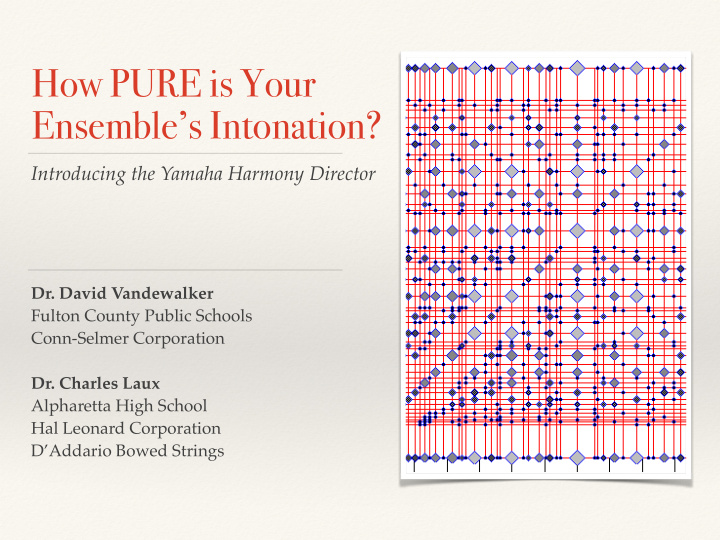



How PURE is Your Ensemble’s Intonation? Introducing the Yamaha Harmony Director Dr. David Vandewalker Fulton County Public Schools Conn-Selmer Corporation Dr. Charles Laux Alpharetta High School Hal Leonard Corporation D’Addario Bowed Strings
Tuning Systems ❖ Equal Temperament ❖ Just Tuning ❖ Pythagorean tuning
Equal Temperament ❖ Our ears have become desensitized due to training with ET ❖ ET dominates and is heard in almost all popular music
Semitone practice in the Mozart household
Why do ensembles play out of tune? ❖ Students play out of tune because the teacher allow it! ❖ Establish a strong value for in tune playing ❖ A non-musician can still discriminate an out of tune performance!
Degrees of intonation ❖ In tune ❖ Very close (1-2 cents off) ❖ Out of tune ❖ Way out of tune ❖ Remember: ❖ A little out of tune is still out of tune! ❖ It only takes one person playing out of tune to make the entire ensemble sound bad!
Prerequisites for good intonation ❖ Good technique ❖ Embouchure, hand position, etc. ❖ Good tone ❖ Good equipment ❖ Bad intonation is almost always a sign of poor technique.
Cautions on using visual tuners… ❖ Students become visually shackled to a tuner and don’t learn how to use their ears ❖ Tuners don’t adjust to different tuning systems and only tune using Equal Temperament ❖ Tuners can be a fabulous teaching tool to develop an Aural image and how to physically manipulate pitch
About the Harmony Director ❖ Yamaha HD-200 Harmony Director ❖ Will play in Equal Temperament and Just Intonation ❖ Manual or Auto modes when in Just Intonation ❖ A unique tool and very practical ❖ Extremely customizable! ❖ Helps train the ears, not the eyes!
Unison Band Warm-Ups
Effect of Timbre on Tuning ❖ Does timbre (tone color) impact the ability to tune accurately? ❖ Experiment with different timbres in your classroom ❖ Greer (1969) found that brass players tuned more accurately with like-timbre instruments and that timbres that lacked overtones (like an oscillator) posed problems with accurate tuning
What type of Intonation should we teach ? Diatonic Intervals Chromatic Interval Open Fifth Basic Harmony
Demonstrating Harmony Basics
A Balanced Major Chord ❖ In addition to tuning, balance is important! ❖ 50% tonic ❖ (35% lower tonic, 15% higher tonic) ❖ 15% 3rd. (Color chord) ❖ 35% 5th
Resources ❖ Bravo Music “Basic Training for Concert Band” - Director’s Guide and Supplemental Exercises ❖ Garofalo - “Improving Intonation in Band and Orchestra Performance” ❖ Jagow -“Tuning for Wind Instruments” ❖ Fabrizio -“A Guide to the Understanding and Correction of Intonation Problems “
Tuning Apps ❖ Tonal Energy Tuner (iOS/Android) ❖ Allows playing in Just Intonation ❖ Attach compatible MIDI keyboard to iPad and play in Just Intonation ❖ ClearTune ❖ Peterson strobe tuner
References ❖ Duffin, R. W. (2008). How equal temperament ruined harmony (and why you should care). W. W. Norton. ❖ Greer, R. D. (1969). The effect of timbre on brass-wind intonation. University of Michigan). ❖ Laux, C. (2015). The effect of a tonic drone accompaniment on the pitch accuracy of scales played by beginner violin and viola students. (Electronic Dissertation). Retrieved from https://etd.ohiolink.edu/
Special Thanks ❖ Yamaha Corporation ❖ Conn-Selmer ❖ Hal Leonard Corporation ❖ D’Addario Orchestral Strings
Contact Us! ❖ Dr. David Vandewalker ❖ vandewalkerd@fultonschools.org ❖ Dr. Charles Laux ❖ CharlesLaux1@gmail.com Slides and more resources available at: www.orchestrateacher.net
Recommend
More recommend